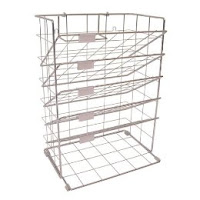According to Ann Mulcahy, Xerox CEO ("Paper Trail," Wall Street Journal interview, 3/9/09), paper has continued to grow over the last thirty years, with the printing of emails being a major culprit.
You would think that our paper consumption would decrease with the use of the internet, right? Yet 95% of all information is still processed in paper form according to Frank Booty ("Managing the Paper Trail," Systems I New UK, 3/01/07).
What can we do to reverse this trend? Here are a few suggestions:
1. Don't print emails or other digital products. Instead, file them on your computer if you need to keep the information. Create folders on your email account or copy the document and file it with your computer documents. Daniel Lyons reports that more than 40% of printouts are discarded within 24 hours, according to Xerox research ("The Paper Chasers," Newsweek 12/01/09).
2. Pay bills online. Not only does this save paper, but it saves time and money. It's so much easier to click than write a check, mail it, etc. And it's cheaper to process digital transactions than paper ones.
3. Ask investment firms, catalog companies, phone books companies, and others to stop mailing their information to you. Otherwise you may be deluged with quarterly reports, catalogs and other printed materials that you will inevitably toss.
4. Re-use paper that has been printed on only one side. For items that need not be in pristine condition, print on the blank side of these papers. Test runs, maps, drafts, and other such items are great candidates for eco-friendly printing. Just make sure that papers containing confidential information are not used for this task!
5. Keep track of the printed information you must keep in order to avoid replacing it. According to the Delphi Group out of Boston, 15% of all paper handled in business is lost, as reported by Jane M. Von Bergen (Knight Ridder Newspapers, The Boston Globe, 3/21/2006).
6. Recycle! According to Mike McConnell, all paper types can be recycled. ("Talking Trash," Journal of Property Management, 7/01/07 Statistic, EPA). Designate recycle containers both at work and at home for paper products.
If your area does not recycle (shame on them!), find the nearest recycle center. Many schools have such containers. Or find a company that will collect your paper products. Shredding companies will periodically offer free shredding of sensitive documents, as well.
7. Use recycled paper products. Not only toilet paper, napkins and paper bags, but computer paper, too! Look for the recycle symbol on the products you buy.
8. Use cloth instead of paper napkins, paper towels, and diapers whenever possible.
9. Use washable plates, glasses and mugs instead of disposable paper products as much as possible.
10. Reduce paper consumption and clutter by reading newspapers and magazines online rather than in print version. Or share a subscription with someone else. Buy ebooks when available.
Give us your eco-friendly suggestions!
More on paper:
Managing Paper
Sorting Mail
A very simple filing system for email and paper























